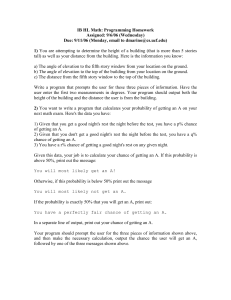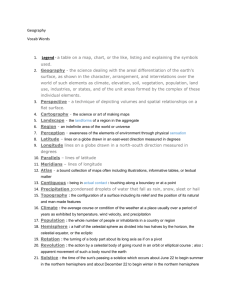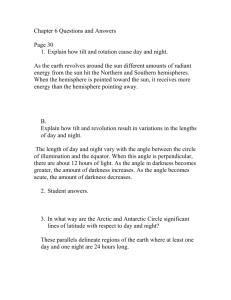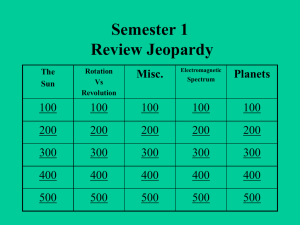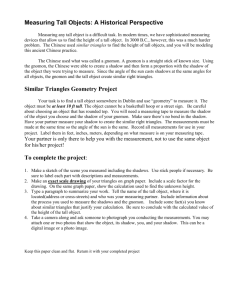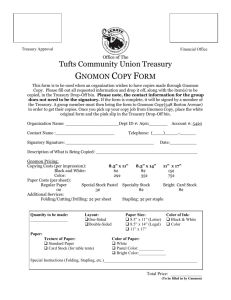Determining Latitude with a Gnomon (due September 30)
advertisement
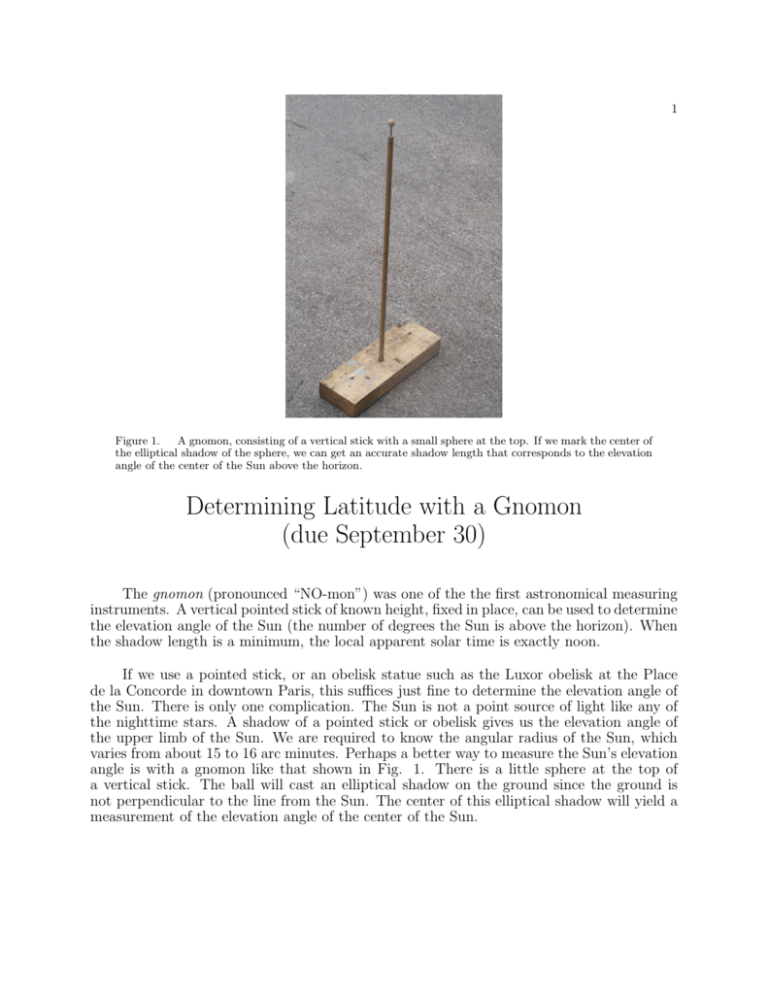
1 Figure 1. A gnomon, consisting of a vertical stick with a small sphere at the top. If we mark the center of the elliptical shadow of the sphere, we can get an accurate shadow length that corresponds to the elevation angle of the center of the Sun above the horizon. Determining Latitude with a Gnomon (due September 30) The gnomon (pronounced “NO-mon”) was one of the the first astronomical measuring instruments. A vertical pointed stick of known height, fixed in place, can be used to determine the elevation angle of the Sun (the number of degrees the Sun is above the horizon). When the shadow length is a minimum, the local apparent solar time is exactly noon. If we use a pointed stick, or an obelisk statue such as the Luxor obelisk at the Place de la Concorde in downtown Paris, this suffices just fine to determine the elevation angle of the Sun. There is only one complication. The Sun is not a point source of light like any of the nighttime stars. A shadow of a pointed stick or obelisk gives us the elevation angle of the upper limb of the Sun. We are required to know the angular radius of the Sun, which varies from about 15 to 16 arc minutes. Perhaps a better way to measure the Sun’s elevation angle is with a gnomon like that shown in Fig. 1. There is a little sphere at the top of a vertical stick. The ball will cast an elliptical shadow on the ground since the ground is not perpendicular to the line from the Sun. The center of this elliptical shadow will yield a measurement of the elevation angle of the center of the Sun. 2 Figure 2. The celestial sphere. The celestial meridian separates the east half of the sky from the west half of the sky. The celestial meridian goes from the north point on the horizon, through the North Celestial Pole (very close to the North Star, Polaris), through the zenith (i.e. “straight up”), and down to the south point on the horizon. The elevation angle of the North Celestial Pole is equal to the observer’s latitude φ (“phi”). A celestial object on the celestial equator will cross the meridian at an elevation angle above the horizon equal to 90◦ − φ. If that object has declination δ (“delta”) it will cross the meridian at an elevation angle above the horizon of 90◦ − φ + δ. This pertains to objects that cross the celestial meridian south of the zenith, such as the Sun and Moon at mid-northern latitudes. Diagram courtesy of James Kaler. 3 Consider Fig. 2. This is the sky as seen in our horizon system of coordinates. Azimuth runs from the north point on the horizon clockwise around the horizon. So the north point on the horizon has azimuth 0 degrees, the east point has azimuth 90 degrees, the south point has azimuth 180 degrees, and the west point has azimuth 270 degrees. Elevation angle (also called “altitude”) is zero on the horizon and is 90 degrees at the zenith (i.e. “straight up”). The celestial meridian separates the east and west halves of the sky. It runs from the north point on the horizon, through the North Celestial Pole (NCP), through the zenith, and down to the south point on the horizon. By definition your latitude φ (“phi”) is equal to the elevation angle of the NCP above the horizon. Since the zenith is 90 degrees above the horizon, the angular distance between the NCP and the zenith is 90◦ − φ. Since the celestial equator is 90 degrees from the NCP, the intersection of the celestial meridian and the celestial equator is φ degrees from the zenith. Also, the intersection of the celestial equator and the celestial meridian is 90◦ − φ above the south point on the horizon. On the first day of spring and the first day of autumn the Sun is on the celestial equator. Its declination δ (“delta”) is zero. But because the axis of rotation of the Earth is tilted some 23.4 degrees to the plane of its orbit around the Sun, the declination angle of the Sun will vary between −23.4 deg and +23.4 deg. The apparent motion of the Sun through the sky traces out the ecliptic. This great circle is tilted 23.4 degrees with respect to the celestial equator. This tilt is called the “obliquity of the ecliptic” and is designated by the Greek letter ǫ (“epsilon”). This tilt is the cause of the seasons. People who live in mid-northern or mid-southern latitudes know that the Sun is highest in the sky at local noontime on the first day of summer and lowest in the sky at local noontime on the first day of winter. If we have a table of the Sun’s declination for every day and hour of the year we could use a gnomon on one day to determine our latitude. This comes from the fundamental formula: hmax = 90◦ − φ + δ , (1) where hmax is the maximum elevation angle of the Sun. Say you were the first astronomer ever and all you knew is that you lived on a spherical Earth. (Aristotle suggested this on the basis of the phenomenon of lunar eclipses. Sometimes the full Moon moves through the Earth’s shadow. The shape of the shadow is always circular, and this can only be so if the Earth is very close to being spherical.) If you are the first astronomer ever, you do not know your latitude and you do not know the obliquity of the ecliptic. In this exercise you will use data taken on the first day of summer and the first day of winter to determine the latitude of a location in College Station, Texas. You will also be able to measure the obliquity of the ecliptic (ǫ). The data were taken in the Cynthia Woods Mitchell garden off the third floor of the Mitchell Physics Building at Texas A & M University. 4 How can this be done? For mid-northern observers, on June 21st we have: hmax (Jun 21) = 90◦ − φ + ǫ . (2) And on December 21st we have: hmax (Dec 21) = 90◦ − φ − ǫ . (3) φ = 90◦ − [hmax (Jun 21) + hmax (Dec 21)]/2 . (4) Eq. 2 plus Eq. 3 gives us: And Eq. 2 minus Eq. 3 gives us: ǫ = [hmax (Jun 21) − hmax (Dec 21)]/2 . (5) In other words, if we can determine the maximum elevation angle of the Sun on June 21st and December 21st, the average gives us 90◦ − φ, and half the difference gives us ǫ. To do: 1. Consider the measurements of the length of a gnomon’s shadow given in Tables 1 and 2. On June 21, 2010, we used a gnomon of length 632 ± 1 mm. On December 21, 2010, we used a gnomon of length 550 ± 1 mm. Using the Central times given in column one, fill in column 2 of each table, giving the decimal number of minutes since noontime. (This is Central Daylight Time for Table 1 and Central Standard Time for Table 2.) 2. Make a plot of the data in Table 1. Draw a line that fits the data. This can be done by hand. What does it mean “to fit”? A good line will have some number of points above the line and approximately an equal number of points below the line. There are a number of ways to make a bad plot. As Fig. 3a shows, a program that plots the points correctly may not overplot a function that actually fits the data. Why? Because if the fitting function is a parabola, but the data set is not a parabola, the fit will be incorrect. If you are plotting the data with Excel using the “line plot” option, this is a mistake. Do not make a “connect the dots” plot, as in Fig. 3b. If the data has unequal time spacing between points, as our data set does, an Excel line plot will have a variable X-axis scale from point to point. Excel’s “ scatter plot” option does better, but it is not foolproof. L (mm) 450 incorrect 300 5 150 a) 0 -150 -100 0 50 100 150 incorrect (do not connect the dots) 600 L (mm) -50 500 b) 400 -150 -100 -50 L (mm) 600 0 50 100 150 0 50 T − t0 (minutes) 100 150 correct 500 400 -150 c) -100 -50 Figure 3. Three examples of plots. Fig. 3a is no good because the function clearly does not fit the data points. Fig. 3b is no good because it assumes that there are no ploblems with any of the data points, and it is a “connect the dots” plot. Fig. 3c shows the same data as in Fig. 3b, but we decided that two of the points are “outliers”. They should be excluded from any fit. A parabola can fit the other points very well. Fig. 3c shows a good plot. The data points are the same as shown in Fig. 3b, except it was decided that two of the points were “outliers”. They are further from the best line than three times the average scatter of the other points from the best line. How can one decide for sure which points, if any, are outliers? This takes experience and some educated guessing. It can be that there are no outliers. In that case one can use all the points. If there are any outliers they must be eliminated from any subsequent analysis. In a case like the data in Fig. 3a, while there are no outliers, one might make a polynomial fit to a subset of the data close to the bottom of the curve in order to find the best value of the minimum shadow length. 3. Once you have determined the minimum shadow length Lmin , you obtain the maximum elevation of the Sun as follows: tan(hmax ) = g Lmin . (6) 6 This is the same as: hmax = arctan g Lmin . (7) For the June 21st observations the gnomon height g = 632 ± 1 mm. You will need a calculator that can calculate the arctangent of some number in order to obtain hmax in degrees. The “arctangent of X” means “the angle whose tangent is equal to X”. If you get a value in the range 0.6 to 1.5, that means that your calculator was set to radians, not degrees. (1 radian = 180/π degrees.) You want to get the value in degrees, not radians. 4. Now make a graph of the data from Table 2. Determine the minimum shadow length Lmin . Use Eq. 7 to obtain the value of hmax for December 21st. Remember to use g = 550 mm for this date. There may or may not be outliers in the data. 5. Now use Eq. 4 to determine the latitude where the data were taken. This uses the maximum elevation angle of the Sun as measured on the two dates. Give your answer for the latitude as some number of degrees and some number of arc minutes. If the value is, say, 30.1234 degrees, this is the same as 30 deg plus 0.1234 times 60 (which equals 7.4) arc minutes. Round off your answer to the nearest 0.1 arc minute. The symbol we use for arc minutes is ′ . 6. Use Eq. 5 to determine the obliquity of the ecliptic. Once again, give your answer in degrees and arc minutes. Round off your answer to the nearest 0.1 arc minute. 7. Google Earth tells us that the latitude of the Cynthia Woods Mitchell garden is 30◦ 37.′ 2. What is the systematic error of our measured value of latitude? The “systematic error” is the arithmetic difference of the measured value and the “true” value. (Usually, in science we do not know the true value of what we are measuring!) Note that each arc minute of latitude corresponds to 1 nautical mile. 8. If the correct value of the obliquity of the ecliptic in this decade is 23◦ 26.′ 2, what is the systematic error of our result? 9. Note that we have said nothing about how level was the spot where the solar shadow measurements were made. How vertical was the gnomon? How straight was the gnomon? Are you impressed that the final results are less than half a degree from the right answers? 10. A good report has at least one introductory paragraph and at least one concluding paragraph. Your report should show your work, and it should not be a rough draft showing just a bunch of calculations. Your report should have many complete sentences, and a 7 combination of words and calculations. You will have to copy into your report some of the equations given above so that a reader can easily understand what you worked through. The reader should not have to refer to this handout to be reminded of what any equation is. Your report should also include Tables 1 and 2, with column 2 filled in by you. You will note that the minimum shadow length did not occur at exactly 12 noon (standard time) on December 21st, or at exactly 1 PM (daylight time) on June 21st. Why is this? If one degree of longitude corresponds to 4 minutes of time, how many degrees of longitude west (or east) are we from the 90 degree meridian of longitude? 11. Most everything you need to know about determining your latitude with a gnomon (and perhaps more than you want to know) can be found at this website: http://faculty.physics.tamu.edu/krisciunas/gnomon.html 12. To turn in: a) A report with some introduction and a description of what you did to obtain the latitude and the obliquity of the ecliptic (i.e. show your work) b) Tables 1 and 2, with column 2 filled in c) Two graphs, with axes appropriately labeled (i.e. “Shadow length (mm)” vs. “Time since noon (min)”). You have the option to draw in the best fit lines by hand. Label any outliers. d) Conclusions about using such a simple device to take astronomical data e) Staple your pages together! 8 Table 1. Measurements of shadow length (21 June 2010; gnomon height = 632 ± 1 mm) Time (CDT) hh:mm:ss Time since noon (decimal minutes) Shadow length L (mm) 11:25:00 11:35:00 11:46:30 11:55:00 12:06:17 −35.0 −25.0 −13.5 −5.0 +6.283 330.0 300.5 268.5 245.5 217.0 12:15:04 12:25:02 12:35:01 12:45:06 12:55:00 196.0 172.0 151.0 131.0 112.5 13:00:10 13:05:00 13:10:47 13:15:00 13:20:00 104.0 99.0 92.5 88.5 86.5 13:25:00 13:30:10 13:37:20 13:45:00 13:49:30 86.0 86.0 92.0 101.0 106.0 13:56:00 14:04:30 14:15:00 14:25:00 14:38:12 117.0 132.0 154.0 175.5 206.0 14:45:00 14:55:00 15:05:00 15:15:00 15:25:00 224.0 247.5 275.0 303.0 331.5 9 Table 2. Measurements of shadow length (21 December 2010; gnomon height = 550 ± 1 mm) Time (CST) hh:mm:ss Time since noon (decimal minutes) Shadow length L (mm) 11:07:45 11:15:00 11:25:00 11:35:15 11:49:20 −52.25 −45.00 −35.00 −24.75 −10.667 844.0 829.0 807.0 787.0 770.0 11:59:20 12:10:00 12:15:00 12:20:00 12:25:15 761.5 756.5 734.5 754.0 754.0 12:30:00 12:36:00 12:40:38 12:45:18 12:50:00 755.0 756.5 759.5 761.5 765.5 12:55:43 13:00:00 13:05:20 13:10:06 13:20:00 771.0 775.0 782.0 788.5 805.0 13:30:00 13:40:00 13:50:00 14:01:20 14:10:50 824.5 848.0 875.0 910.0 946.0 14:20:06 987.0
